In Hesiod's Theogony we are told of
twelve pre-Olympian gods known as Titans, who ruled the Universe.
These were the children of Gaia, who gave birth to the "elder" gods
by cohabiting with Uranus. The important Titans included Oceanus,
Tethys, Mnemosyne, Themis, Hyperion, Lapetus, and Atlas. When Uranus
attempted to imprison the Titans within the body of his wife (the
earth), Cronus, "the youngest and most terrible of her children,"
conspired with his mother and castrated Uranus with a sickle. The
mutilation of Uranus separated Heaven from Earth and succeeded in
freeing the Titans. When the powerful Cronus later cast the severed
genitals of his father into the sea, a white foam enveloped them
from which Aphrodite was born; thus the name aphros, or
"foam-born."
As the newly crowned king of the
gods, Cronus married his sister Rhea. Six famous god-children were
born of their union: Hestia, Demeter, Hera, Hades, Poseidon, and
Zeus. Mother Earth and Father Uranus warned Cronus that his
offspring would someday try to overthrow and replace him as the king
of the gods. Cronus therefore attempted to circumvent the
possibility of threat by swallowing each child whole as it was born.
Rhea was displeased and, "cunning as the night air," replaced baby
Zeus with a cloth-wrapped stone which Cronus unwittingly swallowed
instead. She then hid Zeus at Crete where he was fed on the milk of
the goat Amalthaea and remained until adulthood, protected by the
nymphs.
Years later, Zeus made Cronus
regurgitate his brothers and sisters. A fierce ten-year war ensued,
and the younger, more powerful Olympians overthrew the elder Titans,
casting them down into Tartarus where they (except for Hecate) were
to remain fettered forever. Eventually Zeus reconciled with the
Titans and proclaimed Cronus the ruler of the Golden Age. Meanwhile
he summoned his brothers, Hades and Poseidon, and decreed that the
universe should thereafter be divided among them. The sky became the
dominion of Zeus; Poseidon was chosen to rule over the sea, and the
inner-earth or underworld was declared the haunt of Hades;
notwithstanding the surface of the earth was determined neutral
grounds—a place where sky, sea and underworld joined, and where all
deities could merge.
Sky, sea, and underworld inhabited by
"gods", with earth the mutual gathering ground? The Bible mentions
the same as where powerful spirits are separated.
But let's go on...
Hades and the Mystery Rituals
The Thesmophoria was the most popular of the
ancient Greek fertility festivals. Held in honor of Demeter—whose
cult secrets were the most protected of the mystery religions—the
rituals were performed inside of the inner sanctum of the Temple of
Demeter (the Telesterion) and were so well-guarded by the Temple
devotees that little survived to enlighten us as to what actually
occurred there. Only those portions of the Thesmophoria held outside
the Temple were recorded, providing a sparse historical record.
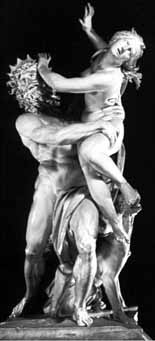 What
is known is that the rituals of the Thesmophoria were based on the
mythology of the abduction and rape of Persephone (Proserpina), and
of Demeter's (Persephone's mother) subsequent actions in searching
for her daughter. The cult's rituals, therefore, are interpreted
according to the Demeter myth, which claimed that Hades—the dark god
of the underworld—fell in love with beautiful Persephone.
What
is known is that the rituals of the Thesmophoria were based on the
mythology of the abduction and rape of Persephone (Proserpina), and
of Demeter's (Persephone's mother) subsequent actions in searching
for her daughter. The cult's rituals, therefore, are interpreted
according to the Demeter myth, which claimed that Hades—the dark god
of the underworld—fell in love with beautiful Persephone.
One day as Persephone plucked flowers in a grassy
meadow, Hades swooped down in his chariot and dragged her into the
underworld, where he forced her to become his bride. Above ground,
Demeter was distraught by her daughter's disappearance and searched
the earth in vain to find her. With the help of Helios and Hecate,
Demeter finally discovered the truth about what had happened. In her
fury, she demanded Hades release her daughter. When he refused, she
sent horrific famine upon the earth. Plants dried up; Seeds refused
to sprout, and the gods began to suffer from a lack of sacrifices.
Finally, Zeus dispatched Hermes to intercede with
the lord of the underworld. After great debate, Hades agreed to
release Persephone if she would eat a pomegranate seed. What
Persephone didn't understand was that by eating the pomegranate seed
in the mystical location of the underworld, divine symmetry was
created that bonded her with Hades. This ensured that the goddess
would automatically return to the underworld for a third part of
each year (in the winter), during which time the seeds of the ground
would not grow. Persephone thus became the upperworld goddess of
youth and happiness, and the underworld queen of the dead; a dual
role that depicted her as both good and evil. On earth she was the
goddess of the young and the friend of the nymphs who appeared in
the blooming of the spring flowers (symbolizing her annual return
from Hades), and in the underworld she was the dreaded wife of Hades
and the Queen of Darkness who controlled the fates of deceased men.
The reenactment of such myth—the abduction and
rape of Persephone—was central to the rituals of the Thesmophoria,
and, as such, key to interpreting the bits of information known.
The festival of the Thesmophoria—sometimes called
the Eleusinian Mysteries—lasted between three and ten days. Each day
of the festival had a different name and included specific rites. A
highlight of the festival was a procession from Athens to Eleusis,
which was led by a crowd of children known as ephebi. The ephebi
assisted in carrying the hiera (sacred objects), and in pulling a
statue of Dionysus as a boy (Iacchos), and finally in the ceremonial
cleansing of the initiates (candidates of the mystery religion) in
the sea.
Upon arriving at Eleusis, the women organized the
first day of the celebration (anodos) by building temporary shelters
and electing the leaders of the camp. On the second day (nesteia)
they initiated the Greater Mysteries which, according to myth,
produced the cult's magical requests (a fertile harvest). Such
mysteries included a parody of the abduction and rape of Persephone
and the positioning of the female devotees upon the ground weeping
(in the role of Demeter for her daughter) and fasting for the return
of Persephone (the return of spring). The setting upon the ground
and fasting also intended to transfer the "energies" of the women
into the ground, and thus into the fall seeds. On the fifth day of
the festival the participants drank a special grain mixture called
kykeon (a symbol of Persephone) in an attempt to assimilate the
spirit of the goddess. The idea was to produce an incarnated
blessing of fertility, both of crops and children.
About this same time certain women called "antleriai"
were cleansed in the sea and sent down into the mountainside
trenches to recover the sacrificial piglets and various other sacred
objects that had been thrown into the hillside canyons several days
before. The sacred objects included dough replicas of snakes and
genitalia, which were burned with the piglets and a
grain-seed-mixture, as an offering to Demeter.
The reason for casting of the piglets into the
mountainside cliffs has been thoroughly debated and no single
interpretation has emerged as final authority. While mystical
representations can be made of the symbology, and the dough replicas
are obviously fertility symbols, pigs blood was sacred to the gods
and thus the piglets are key to understanding the ritual.
Greeks venerated pigs because of their uncanny
ability to find, and unearth, underground items (roots, etc). Some
scholars conclude from this that the ritual casting of the pigs
"into the deep" was a form of imitative magic based on the
underworld myth of Persephone and Hades. That is to say, casting the
piglets into the deep canyon trenches, and fetching them out again,
represented the descent of Persephone into the underworld and her
subsequent return to the surface of the earth.
The piglets in the trenches may also have served
the practical purpose of supplying a host (body) for Persephone to
occupy until the antleriai women could assist her (by retrieving the
piglets) in her annual escape from the underworld. Burning the
piglets later that night would, according to the ancient religious
idea that fire passes the soul from one location to another, free
the spirit of Persephone into the upperworld (compare children
sacrificed to Baal who "passed through the fire" from the physical
world into the spiritual).
Yet the New Testament position seems to be that
such pagan rituals were the worship of demons. "The things which the
Gentiles sacrifice," Paul said, "they sacrifice to devils..." (1
Corinthians 10:20).
This makes one wonder if a connection between the
ritual casting of the piglets into the deep canyon trenches
(representing a descent into hell), and the biblical story of the
Gadarene demoniac, existed.
Consider Luke, chapter Eight:
And they arrived at the country of the Gadarenes....And
when he [Jesus] went forth to land, there met him out of the city
a certain man, which had devils....When he [the demoniac] saw
Jesus, he cried out, and fell down before him, and with a loud
voice said, "What have I to do with thee, Jesus, thou Son of God
most high? I beseech thee, torment me not"....And Jesus asked him,
saying, "What is thy name?" And he said, "Legion:" because many
devils were entered into him. And they besought him that he would
not command them to go out into the deep [emphasis
added]. And there was there an herd of swine
[emphasis added] feeding on the mountain: and they besought him
that he would suffer them to enter into them. And he suffered
them. Then went the devils out of the man, and entered into the
swine: and the herd ran violently down a steep place into
the sea [emphasis added], and were choked. (Luke 8:26-33)
The word deep in this text is Abussos (the
Abyss), and refers to the underworld Bottomless Pit. Since the
principle elements of the sea, the swine, and the deep were
employed; and since the Abyss (part of the underworld) was central
to the narrative; and further since the cult rituals of the
Thesmophoria were well known throughout Asia Minor and were
considered by the Hebrews to be activity of the devil (the
inhabitants of Hades were known as 'Demeter's people,' and Hecate,
the goddess of witchcraft, was Perserphone's underworld guide during
the rituals); one could easily surmise that Jesus was either mocking
the Thesmophoria, or revealing to His followers that such rituals
were the consort of devils. It may be a stretch to interpret the
biblical story in this way, but clearly the similarities and
historical proximities are startling, especially given that the
demons requested entry into the swine.
Why would demons make such a plea? There are two
possible connections with the Thesmophoria: 1) the demons believed
that by entering the swine they could escape the underworld deep (as
in the magical Persephone escape ritual described above); and 2)
Jesus, by granting the request of the devils, was illustrating that
the Thesmophoria ritual of casting piglets into the deep was
inherently demonic. Obviously there are other possible
interpretations of the narrative. Yet since this is the only record
of Jesus granting the petition of demons, it seems possible that a
powerful social commentary on a popular pagan idea, like the
Thesmophoria of Demeter, was made by Christ.
Once upon a time there was this Titan that
escaped Hell
Hecate, the Titan earth-mother of the wizards and
witches, illustrates, perhaps better than Demeter, the connection
between sky, earth, underworld,
and the realm of evil supernaturalism.
As the daughter of Perses
and Asteria, Hecate (Hekate) was the only Titan to
remain free under Zeus. She was the mother of the wizard, Circe, and
the witch, Medea. She characterized the unknown and night-terrors
that roamed the abandoned and desolate highways.
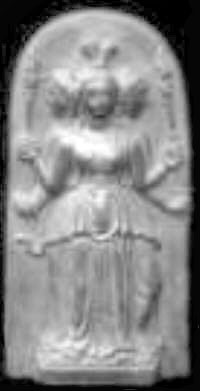 Hecate
was often depicted as a young maiden with three faces, each pointing
in a different direction, a role in which she was the earth-spirit
that haunted wherever three paths joined. As the "goddess of three
forms" she was Luna (the moon) in heaven, Diana (Artemis) on earth,
and Hecate of the underworld.
Hecate
was often depicted as a young maiden with three faces, each pointing
in a different direction, a role in which she was the earth-spirit
that haunted wherever three paths joined. As the "goddess of three
forms" she was Luna (the moon) in heaven, Diana (Artemis) on earth,
and Hecate of the underworld.
At midnight, Hecate's devotees would leave food
offerings at intersections for the goddess ('Hecate's Supper'), and,
once deposited, quickly exit without turning around or looking back.
Sometimes the offerings consisted of honey cakes and chicken hearts,
while at other times, puppies, honey, and female black lambs were
slaughtered for the goddess and her strigae (strigae were deformed
owl-like affiliates of Hecate who flew through the night feeding on
the bodies of unattended babies. During the day, they appeared as
simple old women, folklore that may account for the history of
flying witches. The same hid amidst the leaves of the trees during
the annual festival of Hecate, held on August 13, when Hecate’s
followers offered up the highest praise of the goddess).
Hecate’s devotees celebrated festivals near Lake
Averna in Campania where the sacred willow groves of the goddess
stood, and they communed with the tree spirits (earth spirits,
including Hecate, were thought to inhabit trees) and summoned the
souls of the dead from the mouths of nearby caves. It was here that
Hecate was known as Hecate-Chthonia ("Hecate of the earth"), a
depiction in which she most clearly embodied the popular
earth-mother-spirit that conversed through the cave-stones and
sacred willow trees.
Yet Hecate had other, more revealing names, and
these are the subject of our interest for the time being. These
included: 1) Hecate-Phosphoros ( "The Light Bearer" [recalling
another powerful underworld spirit whose original name was
Lucifer, "the light bearer"]); and 2) Hecate-Propylaia ( "The One
Who Guards The Gate").
Ancient deities known as "light bearers"
guarding gates?
Bible scholars agree that sky, sea, and physical
earth contain spiritual forces behind barriers or 'gates'. In the
Book of Revelation, chapter nine and verse fourteen, we read of
"the four angels which are bound in the great river Euphrates."
Likewise, in Job 26:5, the literal Hebrew translation says, "The
Rafa (fallen angels) are made to writhe from beneath the waters."
Additional biblical references indicate that the subsurface earth
is a prison or holding tank where God has bound certain fallen
entities. (2 Pet. 2:4; Jude 6) That such spirits might seek to
move beyond their confines through human intervention or
invitation, is defined in Scripture. The Hebrew people were warned
not to communicate with spirits seeking to emerge from darkness (
Deut. 18:11), and, as an example, when the witch of Endor
communicated with the same, they ascended up from "out of the
earth" (1 Sam. 28:13).
Based on such scriptures, it seems reasonable
that an intelligent, functioning dynamic exists beyond or behind
mythology, which according to Christian doctrine is identical with
legions of fallen spiritual forces held within spiritual
boundaries. It also appears that, by invitation, they can "ascend"
or transcend these gateways, presenting themselves as 'light
bearers' or angels of light (2 Cor. 11:14).
Following an interview with
Stephen Quayle this last week, I received substantial
email from people wanting to know more about my book
The
Ahriman Gate and the subject of inter-dimensional
doorways. Some wondered of "metaphysical" stargates where astral
soul projection could occur while others had questions about
etheric energy alignments between points in interstellar space
allowing vibrational energies to pass through distances of space
along the space-time continuum. This is what I was talking about
from the moment I mentioned time-dimensional doorways, and the
entities that can and do move through them. Since the beginning of
time and on every continent of the world the record bears the
frightening image of those who often come through:
| |
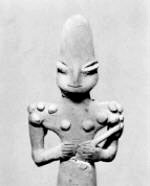 |
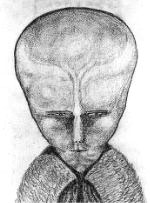
|
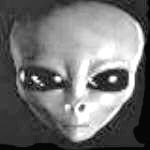 |
|
| |
IN BC 4000 |
IN AD 1918 |
Now |
Back to
Contents
Next - Part Two